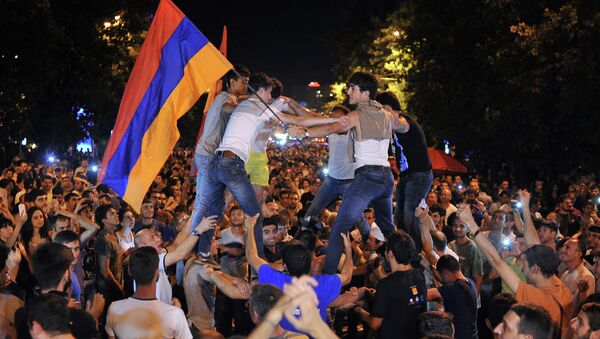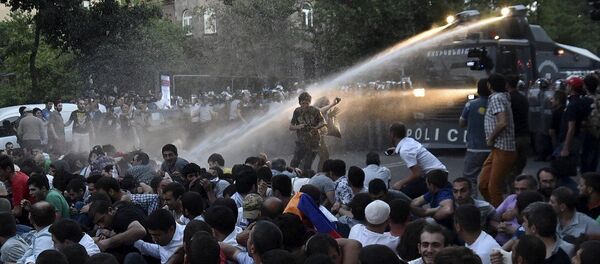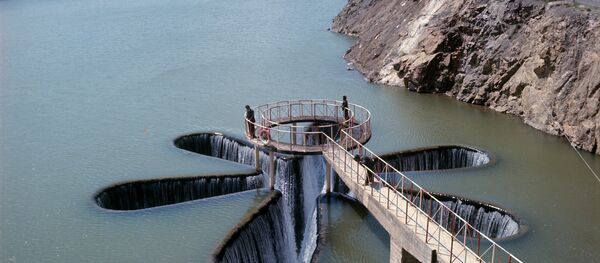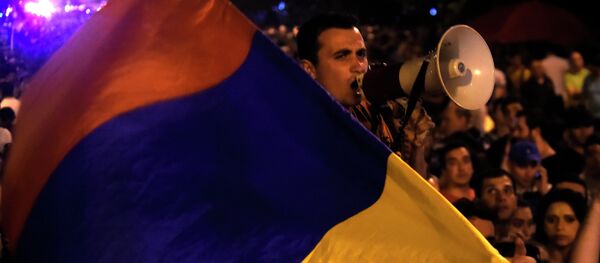Armenia's protests, while allegedly apolitical, have increasingly begun looking like they are more of a political than a social protest. However, their self-proclaimed apolitical nature clash with other factors seen in the protests and the situation surrounding them.
1. Police Tactics Are Strangely Inconsistent
Armenian police also plan to hold a football match with the protesters after the rally on Thursday concludes. Osipyan also refused to remove makeshift barricades at the protests, telling journalists that they don't get in the way of the police.
The combination of the use of force together with an order to not disperse the protest completely was previously been seen at the Ukrainian Euromaidan protests. In Kiev, riot police were ordered back when they were close to dismantling the protest camp, according to reports at the time and later testimonials.
2. Conflicts of Interest Exist Over Electricity Pricing
The privatization and sale of the company to ContourGlobal violated multiple Armenian laws, including Armenia's laws on water resources and its privatization law. The deal, which required parliamentary approval to sell the holding, was negotiated on the executive level by the country's president and its now-ambassador to the US, Tigran Sargsyan.
If the protests do succeed at reversing the price hike decision, they could force the energy distributor, Russian InterRAO-owned Electric Networks of Armenia, which already operates at a loss, out of business and open the company for acquisition, considerably changing the country's energy landscape.
3. Officials Behind the Vorotan Sale Were Removed but Remain Influential
Members of Armenian President Serzh Sargsyan's inner circle, including former Prime Minister Tigran Sargsyan, who became the country's ambassador to the United States after signing an agreement with CascadeGlobal regarding the sale of the Vorotan Hydroelectric Cascade, were later removed from their positions. The country' energy minister at the time, Armen Movsisyan, was also a signatory to the deal.
Armenian political sources initially expected Tigran Sargyan to become an ambassador to Russia or the EU, but he was later made ambassador to the United States. Armenian media alleged as early as 2013 that Tigran Sargsyan could be planning a coup after Armenia joins the Eurasian Customs Union.
Both men have also faced corruption-related inquiries in recent years. Tigran Sargsyan was found to have ownership in an off-shore capital fund during his time as prime minister. Armen Movsisyan, who was able to stay away from corruption-related issues in his 16 years as energy minister was pursued by the Armenian opposition in October 2014 over alleged embezzlement at the Nairit chemical plant whose employees protested unpaid wages for years after it was shut down in 2010.
4. Europe Stays Quietly Supportive
PACE is the only body in which legislators from both EU member states and other European countries meet. Its decisions are seen in the media of countries such as Armenia and Azerbaijan as indicators of European countries' political positions.
Armenia's president went on a visit to Brussels on Thursday to deliver a speech at the European People's Party summit.
5. Azerbaijan Directs Anger at Europe but not Armenia
Armenia's rival Azerbaijan has been relatively silent on the conflict between the two countries. On Thursday, two Azerbaijani soldiers were found dead on the Armenian side of the border, according to Azerbaijani media. However, Azerbaijan, which generally makes statements when the two countries' border conflicts heat up and lead to deaths of soldiers, has been silent on the issue.
Hasanov also spoke out against PACE for its criticism of Azerbaijan and silence on Armenian protests. The deputy head of Azerbaijan Presidential Administration and director of its Foreign Affairs Department Novruz Mammadov said that the statements bring to question Azerbaijan's continued membership in the organization
Azerbaijani parliament member and political analyst Rasim Musabekov told Sputnik Azerbaijan that while the protests appear to be meant as pressure on Russia, it could also be an attempt to change the Armenian leadership.
"I don't exclude that this could be a joint project involving part of the ruling elite," Musabekov told Sputnik Azerbaijan.







